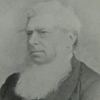Name Henry Robertson Role Politician | Died March 22, 1888 | |
 | ||
Henry Robertson (11 June 1816 – 22 March 1888) was a Scottish mining engineer and prolific railway builder, industrialist and Liberal Party politician. He was head of Brymbo Steelworks , Wrexham. He was co-founder of Beyer-Peacock, with Charles Beyer, and Richard Peacock. His son Sir Henry Beyer Robertson was knighted by Queen Victoria for the achievements of his father.
Contents
- Biography
- Career
- Robertsons railways
- Notable bridges
- Brymbo iron and steel works Wrexham
- Coal and mineral companies
- Charles Beyer
- Political career
- Personal life
- Residences
- References
Biography
The son of Duncan Robertson, he was born in Banff, Aberdeenshire on 16 January 1816, and educated at King's College, Aberdeen University, and graduated M.A. He was initially to enter the ministry but turned to engineering.
Career
He started as a railway contractor securing some contracts at Port Glasgow, under Joseph Locke.
On the offer of a Scottish bank to invest in the North Wales mineral district in 1842, Robertson ventured south, and purchased Brymbo Iron works and colliery, formerly owned by John Wilkinson. Robertson decided for the venture to succeed he needed to build a railway from Brymbo to Connah's Quay to export the coal and iron. This became the North Wales Mineral Railway, which runs from Wrexham to Chester, with a branch to Brymbo. At Chester he had access to the Birkenhead Joint Railway and its associated docks.
Robertson's railways
Robertson was chief civil engineer responsible for the building of the following (often with Thomas Brassey as the construction contractor)
Notable bridges
Robertson's bridges, all in north Wales, included:
Brymbo iron and steel works, Wrexham
Robertson purchased the old iron works of John Wilkinson in 1840. In 1885 he introduced steel-making. Following his death in 1889, his son Sir Henry Beyer Robertson took over and would later (1930s) rescue the plant from bankruptcy following the great depression, and install new blast furnaces.
Coal and mineral companies
Robertson's mining and related interests included:
Charles Beyer
Robertson was co-founder in 1854 of Beyer, Peacock and Co with Charles Beyer and Richard Peacock. Based at Gorton Foundry, in Gorton, Manchester, it would become one of the world's leading locomotive manufacturers. Robertson knew Beyer because he supplied some of the locomotives to his railways. He was a sleeping partner but his connections with the Great Western Railway proved useful in securing orders.
On the recommendation of Thomas Brassey, Robertson provided the loan, when the original loan of banker Charles Geach fell through. Robertson and Beyer subsequently became close friends for life; Beyer was godfather of Robertson's daughter in 1854 and of his son Sir Henry Beyer Robertson ten years later.
Political career
He served as Liberal MP for Shrewsbury from 1862 to 1865 and from 1874 to 1885, and Merioneth from 1885 to 1886, resigning his seat as a result of his opposition to Gladstone's Home Rule Bill.
Personal life
He was a keen walker and enjoyed dancing.
He married Elizabeth Dean in St James Westminster, London in 1848. She was the daughter of a London solicitor .
They had four children. Elizabeth (1851), Annie (1854), Henrietta (1858), and Henry Beyer Robertson (1864).
Residences
1851: Richmond Place, Chester.
1861: St Mary's Court, Shrewsbury. In the 1860s, he also bought a large estate in Crogen, Llandderfel, near Bala, Gwynedd.
1871, 1881: 13, Lancaster Gate, Paddington, London (at the time of the 1871 Census, he was an MP sitting at Westminster). In 1871, he built Palé Hall, a large country house, in Llandderfel, which became his country seat.
He died at Palé Hall on 22 March 1888, aged 71.
